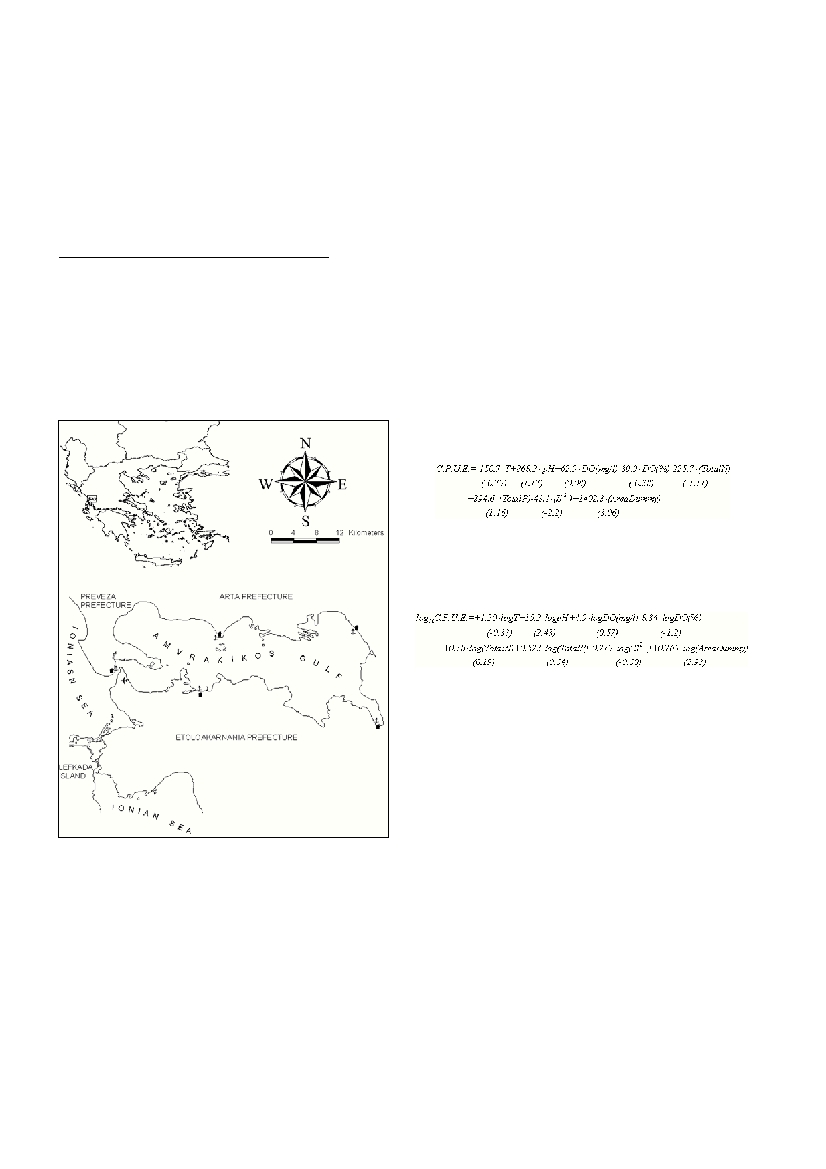Rapp. Comm. int. Mer Médit., 36,2001
255
The shrimp species Penaeus ke
ra t
h u
r
u
sis endemic in North
Mediterranean coast and an important fishery resource for Greece and
Italy.The productivity of this stock has been decreasing the past 20 years
as a result of pollution from coastal human activities and certain aspects of
the species biology that hinder its survival potential. Most important of
these aspects is the preference of the species to utilize closed gulf habitats,
which are more susceptible to pollution and bioaccumulation of pollutants,
which, in turn, reduce the survival rates of the species as well as the fish-
ery productivity.The present study is focused on the Greek population of
the shrimp Penaeus kerathurus located in Amvrakikos Gulf (Western
Greece; Fig. 1). The data were gathered during the project 037/98/EU DG
XIV [1].
Figure 1. GIS map of the study area in Western Greece
The aim of the study is to analyse the population distribution patterns in
Amvrakikos Gulf in relation to the physical and chemical quality on the
sediment level taking into consideration the fact that the species lives on
the sea bottom and usually burrows in the sediment. The means for this
analysis is the fishery productivity index (C.P.U.E.; Catch Per Unit of
Effort) in terms of landings (in g) per 1000 m of trammel net per month,
which gives a direct indication of the distribution pattern of the shrimp in
the Gulf. The physical and chemical parameters which were measured and
used in the modelling, are: temperature (T; °C), pH, dissolved oxygen
(mg/L and % saturation), Total Nitrogen (mg/L), Total Phosphorus (mg/L),
sulfides (by product of H
2
S, in ug/L) and a dummy variable (AreaDummy)
which takes the values 1,2,3 and 4 for the West, North, South and East
parts of the Amvrakikos Gulf. The dummy variable was included in the
model in order to provide a spatial dimension of the fishery productivity.
Cluster analysis of the four regions in Amvrakikos Gulf using all physical
and chemical parameters, showed that there is a great similarity between
the East-South and North-West regions at the 93% and 96% similarity level
(Bray-Curtis dissimilarity index; [2]). The clustering of all regions occurs
at the 70% level, which is high enough. The same results were obtained
from Correspondence Analysis. The conclusion from these analyses is that
the South and East parts of the gulf show high productivity (average
C.P.U.E. =4630.1±456.8g) while the West and North regions show low
productivity (average C.P.U.E. =2212.2±117.4g). The availability of the
shrimps indicates that most of the population is gathered in the South and
East regions of the Gulf. The productivity of the fishery, modelled using a
simple multiple linear regression equation, showed significant correlation.
The equation was found:
r
2
=0.938, P=0, d.f.=8,21, Durbin-Watson=2.434 (t-test in parentheses)
The high correlation showed that the C.P.U.E. index is affected signifi-
cantly by the selected physical and chemical variables. The sensitivity of
the C.P.U.E. to each parameter separately was analysed through a log mul-
tiple regression model. This model using the log10 values of the same
parameters gave also a very good correlation. The log model is the follow-
ing:
r
2
=0.902, P=0, d.f.=8, 26, Durbin-Watson=2.001 (t-test in parentheses)
The coefficients of the log model equal to the sensitivity of C.P.U.E. to
each parameter. From the equation, it is clearly seen that temperature and
dissolved oxygen (mg/L) are extremely important and affect positively
C.P.U.E. Increase of temperature and/or dissolved oxygen (mg/L) will
cause an increase of C.P.U.E. In addition, the Total Nitrogen, Total
Phosphorus and the AreaDummyvariables also affect positively the
C.P.U.E. to a less extent than the others. The % saturation of dissolved oxy-
gen shows a strong negative effect to C.P.U.E. The over-saturation values
measured in various regions seem to affect the C.P.U.E. negatively.The
conclusion of this study is that the physical and chemical quality of the sea
bottom in Amvrakikos Gulf affects significantly the distribution of the
shrimp population of Penaeus kerathurusas measured through the catch
per unit of effort of the fishery activity in the area.
References
1. N.C.M.R. 2001. Study of the current state of fishery of the native
prawnPenaeus kerathuruspopulation in North Mediterranean. Final
Technical Report, Research Project 037/98/EU DG XIV-Fisheries,
Studied for the support of the Common Fishery Policy, pp. 415
2. Ludwig J.A. and Reynolds J.F., 1988. Statistical Ecology. J. Wiley &
Sons, Inc., NewYork, 337 p.
EFFECTS OF PHYSICAL AND CHEMICAL QUALITY OF THE SEA BOTTOM ON THE DISTRIBUTION
OF THE SHRIMP PENAEUS KERATHURUSIN WESTERN GREECE
Alexis Conides
1
*, Febo Lumare
2
, Giuseppe Scordella
2
, Costas Papaconstantinou
1
, Kostas Kapiris
1
and Paraskevi Zacharaki
3
1
National Centre for Marine Research, Hellinikon Athens, Greece - akoni@tee.gr
2
Shrimpculture Research Unit, University of Lecce, Italy
3
Institute of Geology and Mineral Exploration, Athens, Greece
Abstract
Sediment chemical quality and the associated aerobic and anaerobic chemical reactions on the sediment surface affect significantly the
distribution and mortality of species that live on the sea bottom. The shrimp Penaeus kerathurusis native in Greek and Italian waters
(Ionian Sea coasts). An important aspect of the biology of the species is that burrows in the sediment and therefore, pollution from the uses
of the coastal human activities that degrade sediment quality affect the populations significantly. High concentrations of nutrients were
measured in the habitat. resulting in high natural mortality and specific distribution patterns.
Keywords: sediment, Penaeus kerathurus, distribution

